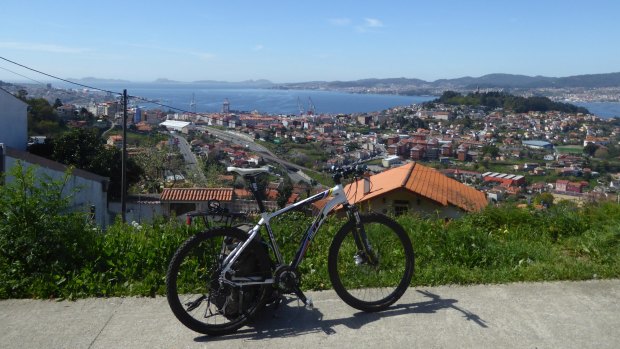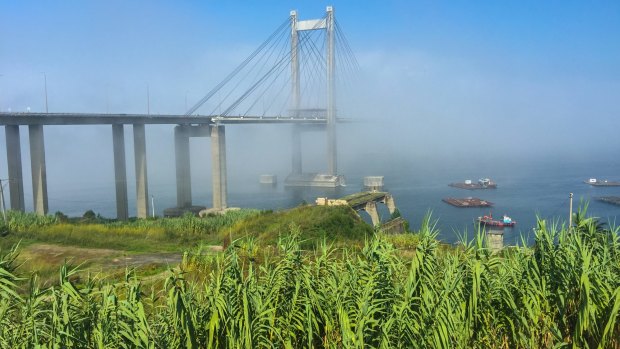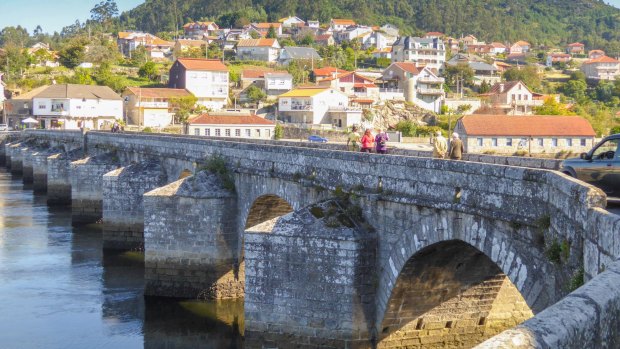This was published 6 years ago
Portuguese Camino Coastal Route by bicycle: An unforgettable journey
This most spiritual of pilgrimages teaches us a thing or two about ourselves.

This epic, seven-day, 278-kilometre cycle from Porto to Santiago de Compostela in Galicia, Spain, is unforgettable.Credit: Follow The Camino
It is not an auspicious start to our Portuguese Camino cycle. A bomb scare outside our Porto hotel keeps us awake the night before departure. It's raining, a chain slips, a tyre punctures and within five minutes, one of us meets a heroic pile of dog dung.
These small annoyances begin the process of focusing the mind. It's a process that will reach fruition at the end of our seven-day, 278-kilometre self-guided cycle from Porto to Santiago de Compostela in Galicia, Spain (five cycle days).
This most spiritual of pilgrimages teaches us a thing or two about ourselves. We are indulged. We're not invincible. Failure happens. It's not the end of the world.

The Camino is clearly a life metaphor.Credit: Follow The Camino
We also unearth some good things. A friend's medical issue means annoyances recede and companions band together. We are, after all, resilient and adaptable. Trying your best is more important than failure, humility more important than accolades, camaraderie more important than condemnation.
We discover that sometimes we become so wrapped up in physical woes that we miss the spiritual and, in doing so, miss the point itself. We learn too that you can eat your body weight in pasteis de nata in the weeks before the trip, and still complete a physically challenging journey. Almost.
Finally, we accept that difficulties should never detract from the splendour of this loveliest of Caminos. Northern Portugal and Spain's Galicia are gifted – visually exquisite, culturally advanced, gastronomically irresistible and historically rich.

As long as you cycle the final 200 kilometres in one stretch, you are entitled to the pilgrim's credential – the Compostela.Credit: Follow The Camino
This is what will stay with us – the opportunity to follow in the steps of pagan, Celtic, Roman, Islamic and Christian wayfarers going back millennia, to challenge ourselves, to find solutions to problems and humour in difficulty.
Sunday riders rather than over-achievers, our group of six friends has cycled many times together. Older, but not necessarily wiser, we book Follow the Camino's new cycle journey along the Portuguese Camino Coastal Route (Caminho da Costa), choosing the final cycle leg from Porto to Santiago de Compostela.
We book a cycle rather than a walk to see as much as possible in a week. The proper way to travel the Camino is probably on foot, in solitary contemplation, and cycling may incline more towards a "paseo en bicicleta". That being said, there are three recognised pilgrimage methods – foot, horseback or bike. As long as you cycle the final 200 kilometres in one stretch, you are entitled to the pilgrim's credential – the Compostela.
We hope the flat coastal route will be easier than the more traditional central route. However, a third of the route is earthen tracks, the traditional teeth-rattling cobblestoned paralelos/adoquin granite sett roads, woodland paths or Roman roads, built from large, flat pavers, so even the shorter, 43-kilometre days can be tricky.
Lucky we have excellent 27-speed mountain bikes though no gel seat or handlebar suspension can alleviate the unremitting jackhammer effect on arms and backside.
These bikes, by the way, arrive encased in boxes at our nice first hotel, the Carris in Porto's central Ribeira district on the Douro River. An Allen key will be required, apparently. They emerge like models on a runway, with only some small adjustments needed, plus the attachment of our traditional pilgrim scallop shell with its red cross of St James.
That lovely city of bridges, Porto, enchants us with its winding, midnight blue river, higgledy-piggledy terracotta-roofed buildings, and its food fresh from the sea. We gorge on sardines, tomato rice, piri piri clams, bacalhau com natas, grilled octopus and Douro Valley wines.
We ride the Gaia cable car, indulge in francesinha open sandwiches with garlicky smoked pork, consume fresh-squeezed street orange juice and pasteis de nata by the bucket-load, do a bit of tapas crawling and six-bridge cruising and even have a little dance in the street. Life is good in this most fabulous of cities.
Day one finds us cycling out along the river, superbly still in early luminous light. Our trials – puncture, slippery conditions, scary bridges and doggie ordure – mean frequent stoppages. Walking pilgrims pass, calling "Buen Camino," their scallop shells swinging jauntily off their packs.
At the narrow mouth of the Douro, we follow the Camino's yellow arrows, heading ever north along miles of white beaches lined with New Zealand Christmas bush and pittosporum.
The rain clears and the coastal bike path stretches flat and easy, interrupted only by boardwalks, cobbles, marble paving, the occasional bird sanctuary and the quaint historic town of Vila do Conde with its glassy river and salty past linking it to the Portuguese Age of Discovery – we cycle an extra six kilometres, just for fun.
Some say there are three Portuguese Ways – Braga, Coastal and Central. Others name ten Portuguese routes for this less travelled of the web of European Caminos that converge, like the lines of a scallop shell at Santiago de Compostela, where reputedly the Apostle James is buried.
In fact, many of the Portuguese ways merge and branch off. On occasion, we depart our coastal route to travel the Caminho de Senda Litoral, the seashore path, before rejoining the main Camino in Redondela in Galicia for the final uphill stretch into Santiago, now the apex of world pilgrimage routes.
After the Camino Frances, the Portuguese Camino is the second most popular route, carrying increasing numbers of Camino pilgrims.
One thing we note: there are few cyclists on our new "surf and turf" Camino cycle and our downloadable notes are for walkers as well as cyclists. Though there's clear general and historic information, the walking/cycling notes are occasionally confusing. Fortunately one of us has an iPhone with power source for Google maps.
We regularly lose ourselves, even on that first day, but locals assist, despite little English. On one occasion, percussive hand clapping denotes the catastrophe that awaits if we stray onto the national road. Yet the boardwalks often forbid cyclists. Confusingly, a bike in a circle means no bike.
Povoa de Varzim is our first night stop and the next day ushers in thick sea mist. Today's cycle will take us across the elegant iron Ponte Dom Luis Filipe that has been the main crossing of the Cavado River for more than a century, through the beautiful town of Esposende, then away from the coast.
It's lovely country with pine, oak and eucalypt woodland, cobbled villages, national park and vineyards, where a farmer presses fresh-picked grapes into our hands and stone-laden woodland waymarkers represent the metaphorical shedding of pilgrims' burdens.
We eventually dismount to push and lift our bikes along mountain hiking tracks and across the Neiva River. As our notes say, "We are coming onto the forest we have to use our hands to pull the bike that's a bit dangerous..."
Surely no more climbs, we think, but another ascent gets us to the crown of the mount and the church of Santiago de Castelo de Neiva, whose 862 inscription shows it's the most ancient church dedicated to St James outside Santiago.
At last we cross the Gustave Eiffel-designed 1878 bridge into Viano do Castelo. Only 43 kilometres today and we're exhausted. The final three days are 60-kilometre cycles. How will we cope? We will cope as others we meet do - the woman in remission from cancer. The elderly man partially paralysed from a stroke. The young girl so tired she needs support in the lift.
The next day is long, beautiful, and difficult. We're delayed two hours when we miss the ferry that crosses the River Minho from Portugal's Caminho to Galicia's A Guarda where the pilgrim greeting turns Spanish: "Bom Caminho".
A friend is unwell and must take a taxi. We eventually arrive through seashore pine and eucalypt forests in the medieval town of Baiona after 8.30pm. Never has bonito del norte, tortilla, empanada, croquettes and Galician octopus in sweet paprika oil tasted so divine.
Day four is all Galician sea and mountains, steep hill climbs, and rain. It's so heavy we ignominiously abandon our cycling at Vigo, ferrying our bikes by train to Pontevedra.
The final leg, Pontevedra to Santiago, is a blur of oak, pine and eucalypt forests, passing Padron, where St James began his mission and to where his body returned after Herod Agrippa beheaded him in Jerusalem.
Heritage-listed Santiago, capital of Galicia in northwest Spain, is thick with pilgrims, all focused on the Cathedral within the old town's medieval walls, consecrated in 1211, where St James is reputedly buried.
We're lucky. The cathedral is hushed and expectant, packed with hobbling, weary, filthy pilgrims, still with backpacks and staffs, some overwhelmed by emotion. It doesn't always happen but tonight we witness the 65-metre arcs of the great Botafumeiro (censer in Galician) as it oscillates to the soaring vaulted ceiling, spreading incense, accompanied by the Hymn of the Apostle.
Has the Way of St James changed these pilgrims' lives? Hard to say, but the Camino is clearly a life metaphor – it's challenging, you want to give up, everyone else copes better. Yet it encourages virtues like courage, acceptance and forgiveness. Unforgettable.
Trip Notes
FLY
Singapore Airlines flies from Sydney and Melbourne to Amsterdam via Singapore. Multiple airlines fly from Amsterdam to Porto and from Santiago to Amsterdam. See singaporeair.com
CYCLE
Follow the Camino's Camino by Bike, Surf & Turf: Porto to Santiago is a seven-day, self-guided cycle including six nights in two to three-star accommodation, breakfast, mountain bike BH Over-X 27V, luggage transfer, some dinners, downloadable notes and pilgrim pack, 24/7 emergency assistance. From €840. See followthecamino.com
More
Alison Stewart was a guest of Follow the Camino
Sign up for the Traveller Deals newsletter
Get exclusive travel deals delivered straight to your inbox. Sign up now.